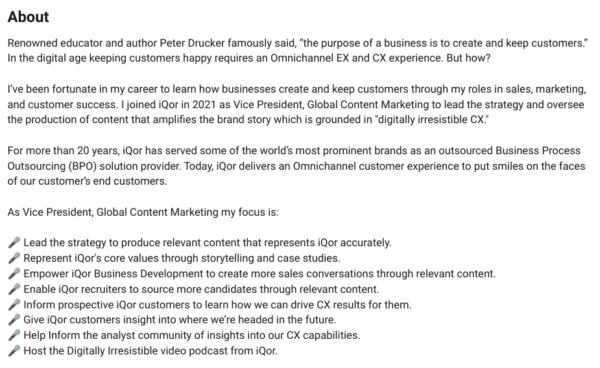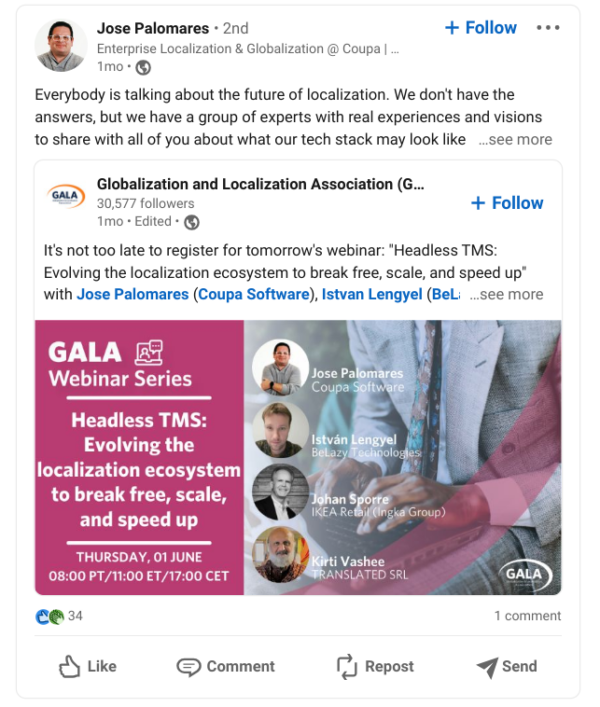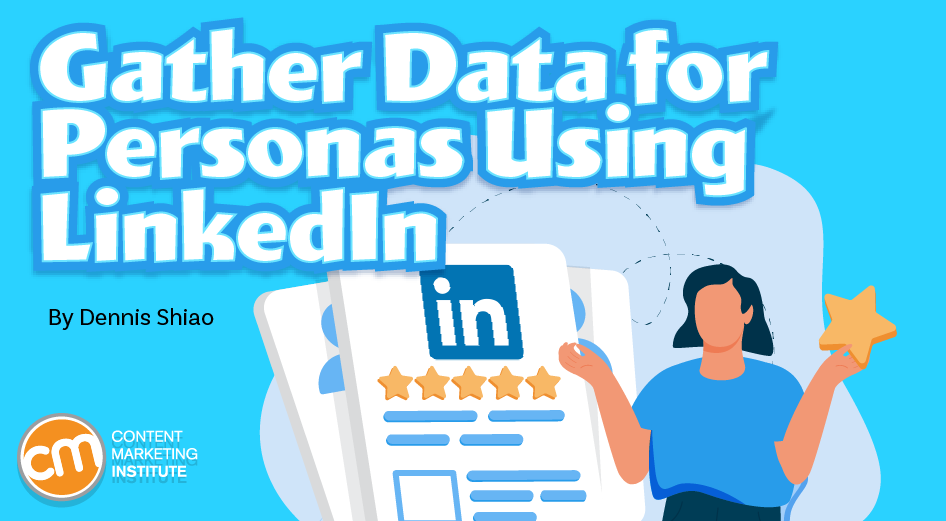I failed.
I helped a client with an account-based marketing (ABM) initiative. We had third-party intent data of companies searching keywords and phrases related to their services. We also had the LinkedIn profiles of those companies’ employees – people who would be likely buyers.
I analyzed the LinkedIn profiles to identify buying signals. Did they post asking about vendor capabilities? Did they ask for vendor recommendations? Or did they request proposals?
The result of my work?
Nothing. None of those LinkedIn profiles signaled that type of buying intent.
While the process failed to deliver actionable results for my client, it better informed my ability to provide well-developed personas to create more effective content marketing.
Researching LinkedIn profiles can provide a wealth of insights. In this post, I show you what you can uncover.
@LinkedIn profiles can provide a wealth of insights about audience personas, says @Dshiao via @CMIContent. Click To TweetFinding your personas on LinkedIn
You first need to generate a list of people to research. Enter a broad descriptive term in the search bar. I usually start with “marketing.”
From there, click on “people” and “all filters.” It returns over 49.5 million results:
Next to the results view are the filter options – a lot of them, including:
- Connections (i.e., degree of connection to your profile)
- Locations
- Talks about
- Current company
- Past company
- School
- Industry
- Profile language
- Open to
- Service categories
- Keywords
Choose the filters based on the nature of your research. For instance, if you focus on a Middle East-based audience, use the locations filter accordingly. Pick “current company” to research people at targeted companies.
To find people in specific roles, filter for title (under the keywords filter). Then type the job title in quotes, such as “senior procurement manager.”
To research B2B content marketers, I typed B2B and “content marketers” into the title search field:

You can create a broad or niche list depending on your filter criteria.
Research LinkedIn profiles
Now that you compiled a list of people, you can assess which ones will be most helpful to your research and identify other profiles to add to your tracker.
Skim past the underpopulated profiles and spend your time on the detailed ones. Give them a glance from top to bottom. Don’t focus solely on the About or Activity sections at the top. The bottom of the profile – volunteering, recommendations, publications, and honors and awards – can reveal interesting nuggets.
Spend research time on detailed @LinkedIn profiles, perusing their information from top to bottom, says @Dshiao via @CMIContent. Click To TweetUse one profile to find more people from the same persona. Much the same way a hyperlink in an article takes the reader to a related article, LinkedIn users provide pathways to profiles from the same persona. Convenient widgets to check on a user’s profile page include “people you may know” and “people also viewed.”
Now, let’s walk through section by section to identify their relevancy and potential insights.
Headline
The headline is listed under their name on the profile page. It also appears when you browse the LinkedIn feed. While many list their job title and organization, others see the headline as an opportunity to make a statement or to stand out.
Think of these custom headlines as a clue that tells you a bit about the person’s missions, motivations, and ambitions. That information can help your understanding of the audience persona they represent.
Let’s consider a few examples of different personas taken from existing profiles, along with the lesson learned:
|
Functional Role |
Headline |
Takeaway |
| Product management | Entrepreneur with passion for developing great products that solve real-world customer challenges | The importance product managers place in having their products solve real-world challenges |
| Product management | Passionate about creating software users love, and working with good people to build them | Idea: Explore the concept that product managers want to work with “good people” to build products. |
| Entrepreneur | Make video content 10x faster for better marketing, comms, and client services | Understand the tangible goal of the product, as well as common use cases. |
| Digital health leader | Growth Focused Commercial Digital Health Leader Committed to Transforming Patient Care with Novel Solutions | Making Big, Innovative Ideas Actionable for >25 Years | The tenure mentioned is interesting. This digital health leader strives to make an impact over the long term. |
| Engineering leader | People are any company’s biggest asset; I pride myself on putting people first. ex Twilio, Microsoft, Komodo Health | A leader of software engineering teams who places her team first |
| Social media marketer | Building stronger relationships through effective content and social media marketing | It’s not all about impressions, shares and likes, it’s also about relationships |
About
LinkedIn users have 2,600 characters to describe themselves in the “about” section. This free-form area only allows plain text – no special formatting, images, or clickable links. The detailed description of their roles and responsibilities can help build a better picture of their associated persona. Let’s look at two examples.
A detailed about section on a @LinkedIn profile can help build a better picture of the associated persona, says @Dshiao via @CMIContent. Click To TweetCristina Crespo is vice president of product at Paytient. The first sentence of her about section concisely explains what product management leaders do: “Product management leader with more than 10 years of experience ideating and launching technology solutions that solve real problems and achieve business outcomes.”

She further describes her comfort with ambiguity and creative mindset “to identify quick wins and a roadmap that evolves through constant learning and experimentation.” Next, Cristina explains how she’s helped organizations achieve revenue growth and includes this bulleted list:
- Conducting qualitative research to identify customer insights
- Articulating the problem and business opportunity
- Defining a compelling product vision and strategy
- Prioritizing solutions and defining a clear go-to-market strategy
- Facilitating iterative design and rapid prototyping with continuous validation
- Testing new product ideas in market with a fail-fast approach
- Measuring and using data to inform product decisions
- Meaningfully growing products to address pain points and market needs
If your audience persona is product managers or product management leaders, this list gives a good sense of their activities.
Next, let’s look at Bernie Borges, vice president of global content marketing at iQor. In his about section, Bernie details his activities and goals:
- Lead the strategy to produce relevant content that represents iQor accurately.
- Represent iQor’s core values through storytelling and case studies.
- Empower iQor Business Development to create more sales conversations through relevant content.
- Enable iQor recruiters to source more candidates through relevant content.
- Inform prospective iQor customers to learn how we can drive CX results for them.
- Give iQor customers insight into where we’re headed in the future.
- Help Inform the analyst community of insights into our CX capabilities.
- Host the Digitally Irresistible video podcast from iQor.

If your company sells a product for content marketing teams, you can learn from Bernie’s list what a content marketing leader does. You can brainstorm blog posts, e-books, and webinar topics that assist someone like Bernie with these activities or help them achieve some of these goals.
Featured
Featured is an optional area that enables LinkedIn users to prominently display their LinkedIn posts, newsletter, and articles, as well as external links and uploaded media.
Brett Durrett is director of product management at Google. Brett’s featured section includes a number of SlideShare presentations from his time at IMVU, including:
- Continuous Deployment at Lean LA
- Learning Fast With A/B Testing and Continuous Deployment
- Lean Startup Pitfalls Uncovered
- Building a Successful Business After Launch
- Leveraging Open Source Software to Maximize Your Development Resources (and the problems you can expect with success)
In each entry, Brett describes the presentation, such as this one for Building a Successful After Launch:
GDC Online 2010 presentation of how IMVU built its product after launching. Includes examples of the testing/experiment systems, reporting, continuous deployment, and process improvement.

If you’re researching the senior vice president of engineering persona, reviewing Brett’s presentations tells you a lot about that role and, in particular, specific attributes of that role at IMVU.
Experience (job detail)
In the experience section, users list their employment history, including job title, organization name, years worked, location, and job details.
A localization program manager at a technology company provided this nugget in her job detail:
Drove $1.4M in cost savings, together with a 20% time-saving, leveraging scalable automation, cross-team process improvement, and company-wide operational efficiencies. This includes utilizing the latest localization technology, workflow automation to reduce manual efforts, and overhauling creative processes for faster time-to-market.
In just two sentences, you learn:
- The quantifiable impacts of her team’s efforts
- The technology she used
- The processes or process changes she implemented
- Additional benefits achieved (e.g., reduced manual efforts, faster time-to-market)
If you create content for localization program managers, you could look to see if your customers have achieved similar results, then interview them to learn more. With those findings, you might conceive a content campaign that shows other localization program managers how they can achieve similar results.
Experience (associated media)
When providing details on a current or past job, LinkedIn lets you add media, such as an image, video, or slide deck, as I did with my presentation 10 Quick Tips for Effective Content Marketing in the example below:

Lisa Gately is a principal analyst at Forrester. She was a senior director of content strategy at Genesys. In that listing, Lisa linked to an article, Confessions of a Content Strategist: Lisa Gately, based on an interview she did with Ahava Leibtag, who published the article on her LinkedIn profile.

The article details what a content strategist does. Some of the questions Lisa answered include:
- How did you get started in content strategy?
- How did you formalize your role as a content strategist in your current environment?
- What was your number one challenge in getting the content strategy team up and running?
- What do you see happening in the future of content?
That interview provides a wealth of information about content strategists and the industry.
Activity
The activity section groups together posts, comments, videos, images, articles, newsletters, and more. Navigate across the tabs to look for interesting things. I like to peek at comments to discover new people to research. After all, someone in one audience persona is likely to engage with other users from the same persona.
Jose Palomares is the director of localization at Coupa Software. In his profile’s posts, he shared industry webinars on which he was a panelist, including the Globalization and Localization Association’s webinar on headless systems:

If your persona was a director of localization, watching the on-demand recordings of these webinars would be helpful. You also can think about whether the webinar topics should be added to your editorial calendar.
Groups (mutual)
LinkedIn users also can add organizations to which they belong in the groups section. Their profiles don’t list all the groups to which they belong. However, the highlights section indicates groups you have in common.
When I visit Rich Schwerin’s profile, I see we have six groups in common, including the Content Marketing Institute and The Content Wrangler Community.

Find relevant LinkedIn groups, visit them, and see what users are posting about. Through Scott Abel’s The Content Wrangler Community, I noticed this post from Heather Hedden about her appearance at Lava Con, a conference for content strategists:

Recommendations
LinkedIn recommendations can be useful because they may detail how a person was exceptional or useful within the context of the role you’re researching. Karen Budell is the chief marketing officer at Totango. When she was vice president of brand marketing at Momentive.ai, she received a recommendation from her boss, Leela Srinivasan:

Here’s an excerpt of the recommendation relevant to Karen’s role in brand marketing:
She brought every ounce of her strategic marketing brain to the table as my partner in crime on the complex and sensitive rebrand of a public company with a global footprint. She adeptly managed multiple agency relationships, helped steer the executive team through a mountain of change, and proved to be a clutch player throughout the journey. She is super smart about creating impactful content and experiences.
With these details, you learn brand marketing executives lead organizations through rebrands, which requires them to navigate agency relationships, as well as relationships with their executive team.
Go deep into LinkedIn profiles
LinkedIn hosts an ocean of information on your audience personas. It also requires no financial investment. You can hit the highlights or go down the rabbit hole of connected research to craft helpful audience research.
Please share in the comments some of the tricks you’ve used in doing persona research on LinkedIn.
HANDPICKED RELATED CONTENT:
Cover image by Joseph Kalinowski/Content Marketing Institute


